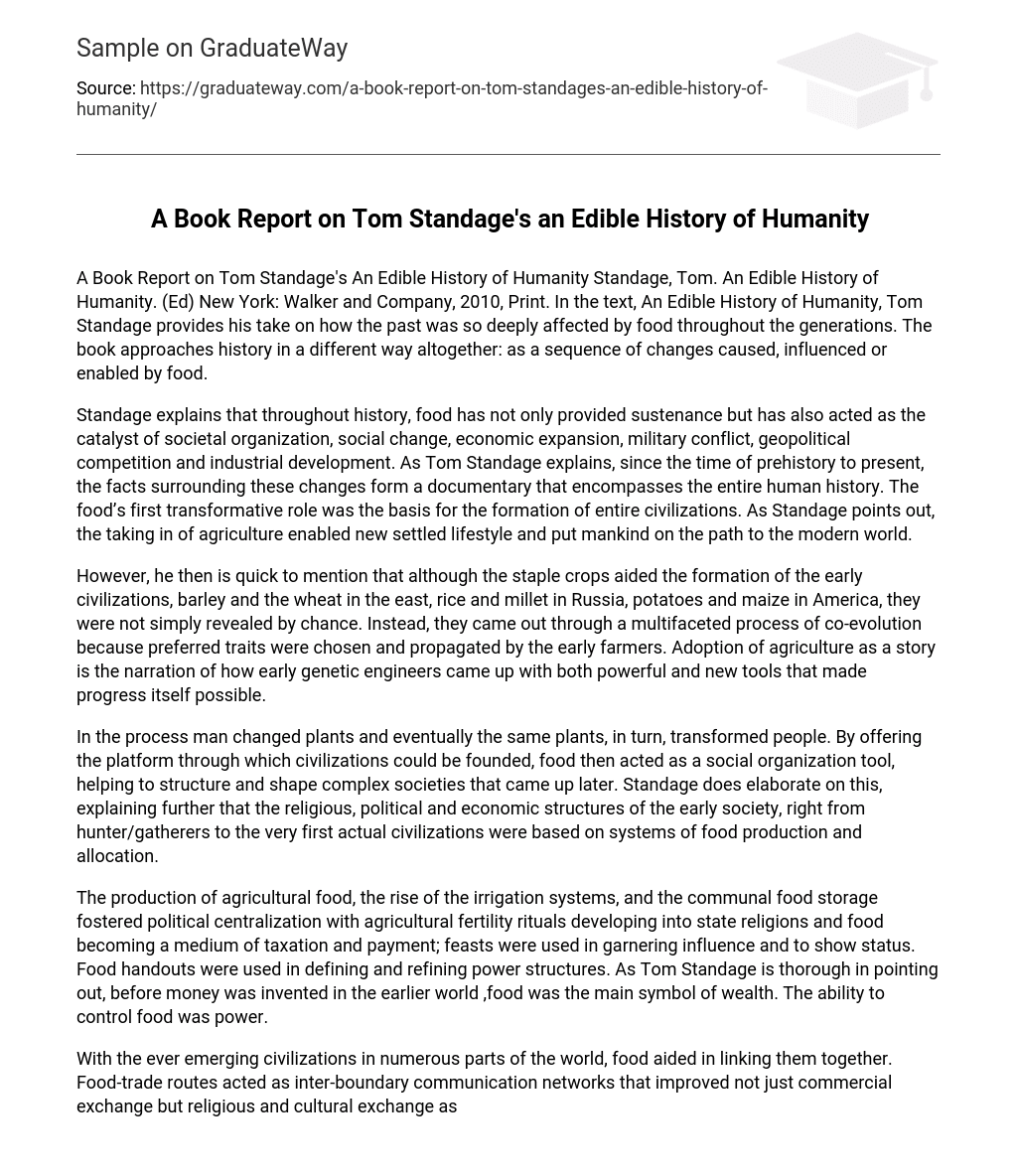Tom Standage’s An Edible History of Humanity explores the profound impact that food has had throughout history. In this book, Standage offers a unique perspective on how food has shaped and influenced the past. Rather than viewing history as a series of events, Standage presents it as a progression of transformations that have been brought about, influenced, or made possible by food. An Edible History of Humanity was published by Walker and Company in 2010.
Tom Standage asserts that throughout history, food has served as more than just a means of nourishment. It has played a vital role in driving societal shifts, fostering economic prosperity, fueling military conflicts, shaping geopolitical rivalries, and spurring industrial advancements. According to Standage, the impact of food on these various aspects of human life can be traced back from ancient times to the present day. The advent of agriculture was a crucial turning point in establishing civilizations and laying the foundation for modern society.
The author acknowledges that staple crops such as barley, wheat, rice, millet, potatoes, and maize played a crucial role in the development of early civilizations. However, it is recognized that these crops did not emerge randomly but instead underwent a complex process of co-evolution. In essence, early farmers acted as genetic engineers by carefully selecting and spreading desired traits. As a result, the history of agriculture revolves around the innovative tools developed by these farmers that propelled advancements.
The process of human interaction with plants led to changes in both, and eventually, these transformed people. Food acted as a platform for the establishment of civilizations, as it helped structure and shape complex societies. Standage provides further explanation that early societies, ranging from hunter/gatherer groups to the first civilizations, based their religious, political, and economic structures on systems of food production and allocation.
The emergence of agricultural food production, irrigation systems, and communal food storage led to political centralization. Agricultural fertility rituals transformed into state religions, and food became a means of taxation and payment. Feasts were used to gain influence and display social status. Distributing food handouts played a role in defining and refining power structures. As Tom Standage emphasizes, prior to the invention of money, food held great significance as a symbol of wealth. Controlling food supply meant having power.
Through the emergence of civilizations around the world, food played a crucial role in connecting them. Food-trade routes acted as networks for communication across boundaries, enhancing not only commercial exchange but also fostering religious and cultural exchange. These spice routes, which extended across ancient civilizations, facilitated cross-cultural fertilization in various fields including architecture, religion, and science. As a result, early geographers started showing interest in distant people and their customs, leading to the creation of the initial world maps.
The dominant cause of the food trade was Europe’s desire to avoid Arab control over spices. This led to the discovery of a new world, the establishment of colonial outposts, and the creation of trade routes across Asia, Europe, and America. As European nations worked on building global empires, food played a crucial role in driving economic development during the industrialization era.
According to Standage, potatoes and sugar played crucial roles in powering the industrial revolution. In the West Indies, sugar production on plantations, which heavily relied on slave labor, served as an early example of industrial processes. Meanwhile, potatoes became a staple food for Europeans, providing more calories per area of land compared to cereals. Standage notes that the combination of potatoes and sugar provided inexpensive sustenance for workers in the factories of the industrial era.
Britain was the birthplace of a decisive answer to the question of whether the country’s future lies in industry or agriculture. This answer came unexpectedly with the Irish potato famine of the mid 19th century. The use of food as a weapon during wars was extremely unfair, but it reached an entirely new level of atrocity during the massive military conflicts of the eighteenth and nineteenth centuries. In both the revolutionary wars of the 18th and 19th centuries, food played a crucial role in determining the consequences for the USA, as the author informs us, the reader.
According to Tom Standage, the mechanization of war in the 20th century prioritized supplying machines with ammunition and fuel over feeding soldiers, which was unprecedented in history. Standage also highlights how food became an ideological weapon during the cold war between communism and capitalism, playing a pivotal role in determining the conflict’s outcome. He further argues that the application of industrial and scientific methods to agriculture during this century significantly boosted food production and consequently led to a population surge worldwide.
According to Standage, the green revolution in Asia during the turn of the century boosted industrialization by increasing food supply faster than population growth. This prompted a change in family planning, as individuals in modern industrial societies began choosing smaller families compared to those in traditional agricultural societies. Consequently, Standage predicts that we will reach the highest point of human population by the end of the 21st century.
Tom Standage has deepened our comprehension of the global importance of food. Although numerous narratives have been shared about individual customs, traditions, and the development of particular national gastronomies, this passage seeks to offer a more comprehensive viewpoint. It does not assert that there is a single definitive method for understanding history, nor does it endeavor to provide an exhaustive chronicle of food’s history or the worldwide history of food.
Incorporating various fields like societal organization, social change, economic expansion, military conflict, geopolitical competition, and industrial development, this text emphasizes the interplay between world history and the impact of food. Tom Standage deftly combines these interconnected factors to create a comprehensive narrative covering all aspects.





